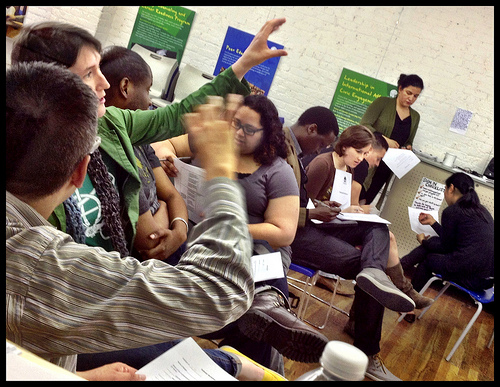Staff noted all sorts of interesting things in their generally successful attempt to build badges from the indicators.
Two trainers were in disagreement about the following indicator: “1.11 Increased college enrollment rate.” To one it was simple just to make that a badge. To another, that was more about an achievement for Global Kids, not the youth itself. Getting into college – that is the desired mark of achievement with which no badge can compete; going to college is the power-up. So the two figured out that our goal is not to turn every indicator into a badge. Instead, the indicators can be used to suggest badges, and badges, in turn, can be used to support the indicator. So no, there will be no “I got into college” badge, but there CAN be a “College Readiness” role badge, earned by collecting the required achievement badges (conferred for visiting at least one college, writing a college essay, and any number of other more discrete but necessary steps for applying for college). In this way, the badging process becomes a form of scaffolded learning, supporting youth along their path to a college acceptance letter.
Other thoughts raised are one we had heard in other GK internal badge meetings, specifically how matching GK programs to a badging system will require more planning from trainers and might change our whole process. This can be for the better, helping us be more rigourous and to plan in advance. This can be for the worse, making us do things just to ensure the youth can get a badge (e.g. talk with an elected official). How we control the badging system (and its affect on our practices) and avoid letting it control us will likely be an ongoing issue.
Another trainer also recognized that, ultimately, each trainer will have their own personal style and approach for certifying badges. Having a solid rubric will be essential to ensure the validity of the badges across the organization.
Those are some of the big picture issues that were raised. More practically, they created many badge ideas from the indicators (such as the Connect-the-Dot badge for integrating a global and local perspective) and began the process of creating organizational-wide badges. The next step is to put them all into a Google Doc spreadsheet over the next two weeks, review what we have, and compare that against what the youth develop off the Letters of Recommendation.


No Comments